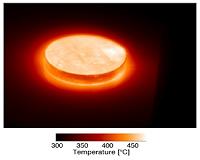 |
Science@NASA Huntsville AL (SPX) Aug 17, 2010 For the next few months, Venus will be softly resplendent in the evening sky, a treat for stargazers - but looks can be deceiving. Consider this: The Venusian surface is hot enough to melt lead. The planet's 96% carbon dioxide atmosphere is thick and steamy with a corrosive mist of sulfuric acid floating through it. The terrain is forbidding, strewn with craters and volcanic calderas - and bone dry. Takeshi Imamura can't wait to get there. Imamura is the project scientist for Akatsuki, a Japanese mission also called the Venus Climate Orbiter. The spacecraft is approaching Venus and will enter orbit on December 7, 2010. Imamura believes a close-up look at Venus could teach us a lot about our own planet. "In so many ways, Venus is similar to Earth. It has about the same mass, is approximately the same distance from the sun, and is made of the same basic materials," says Imamura. "Yet the two worlds ended up so different. We want to know why." Although a parade of U.S. and Soviet spacecraft has visited Venus since 1961, no one yet knows how it became Earth's "evil twin." Did it suffer from a case of global warming run amok - or something else? When Akatsuki reaches Venus in December, it will begin to solve some of the mysteries hidden in the thick Venusian atmosphere. "By comparing Venus's unique meteorology to Earth's, we'll learn more about the universal principles of meteorology and improve the climate models we use to predict our planet's future." Particularly puzzling is Venus's "super-rotation." Fierce, blistering winds propel an atmosphere filled with storms and sulfuric acid clouds in a churning maelstrom around Venus at over 220 miles per hour, 60 times faster than the planet itself rotates. "Venus's atmosphere is in perpetual motion, as if a living thing," says Imamura. Within this swirling cauldron are other Venusian riddles to be solved: What is the origin of the 12-mile thick layer of sulfuric acid clouds that shrouds the planet? And how does Venus' lightning crackle through this strange brew? Akatsuki, bristling with cameras, will circle the exotic planet's equator in an elliptical orbit for at least 2 years, monitoring the atmosphere at different altitudes using various wavelengths (IR, UV, and visible). With this data and data from the spacecraft's radio dish, scientists will reconstruct a 3D model of the atmosphere's structure and dynamics. "The spacecraft's orbit will match the circulation of Venus's clouds, allowing the instruments to monitor cloud movement from directly above for 20 hours at a time. We'll assemble the images to produce a cloud motion time-lapse movie, much like a weather forecaster on television might show you of Earth." The instruments will also scrutinize the planet's surface for volcanic activity that could be contributing to the sulfur contents of the atmosphere. "If any active volcanoes are spouting hot lava on Venus, one of our infrared cameras will detect the thermal emission," says Imamura. In addition, Akatsuki's Lightning and Airglow Camera will hunt for lightning in order to settle a longstanding debate. "On Earth, the standard theory of lightning requires water ice particles on which positive or negative charges are induced via collisions," explains Imamura. "But there are no ice particles in Venus's hot, dry atmosphere--so how does Venusian lightning get started? It may be that charge separation can occur in sulfuric acid clouds--or perhaps some unknown solid particles exist in the atmosphere and play an important role." Imamura can scarcely contain his curiosity. "As a young boy I loved to watch clouds, stars, oceans, rocks, and creatures. I wanted to understand why they look and behave as they do. Now I am curious in the same way about Venus. Nature is so full of mysteries!" Beginning in December, some of Venus's mysteries will be revealed. Stay tuned.
Share This Article With Planet Earth
Related Links Venus Climate Orbiter (Akatsuki) Venus Express News and Venusian Science
 Recreating Venus In The Lab
Recreating Venus In The LabParis, France (ESA) Aug 02, 2010 Scientists are able to learn about the atmospheres and surfaces of planets by studying their spectra - the different wavelengths of light which they reflect or absorb. However, when researchers study spectra of Venus, the hottest planet in the Solar System, they run into a problem. Its high temperatures and pressures seriously affect the data. Venus and Earth are often described as sister ... read more |
|
| The content herein, unless otherwise known to be public domain, are Copyright 1995-2010 - SpaceDaily. AFP and UPI Wire Stories are copyright Agence France-Presse and United Press International. ESA Portal Reports are copyright European Space Agency. All NASA sourced material is public domain. Additional copyrights may apply in whole or part to other bona fide parties. Advertising does not imply endorsement,agreement or approval of any opinions, statements or information provided by SpaceDaily on any Web page published or hosted by SpaceDaily. Privacy Statement |